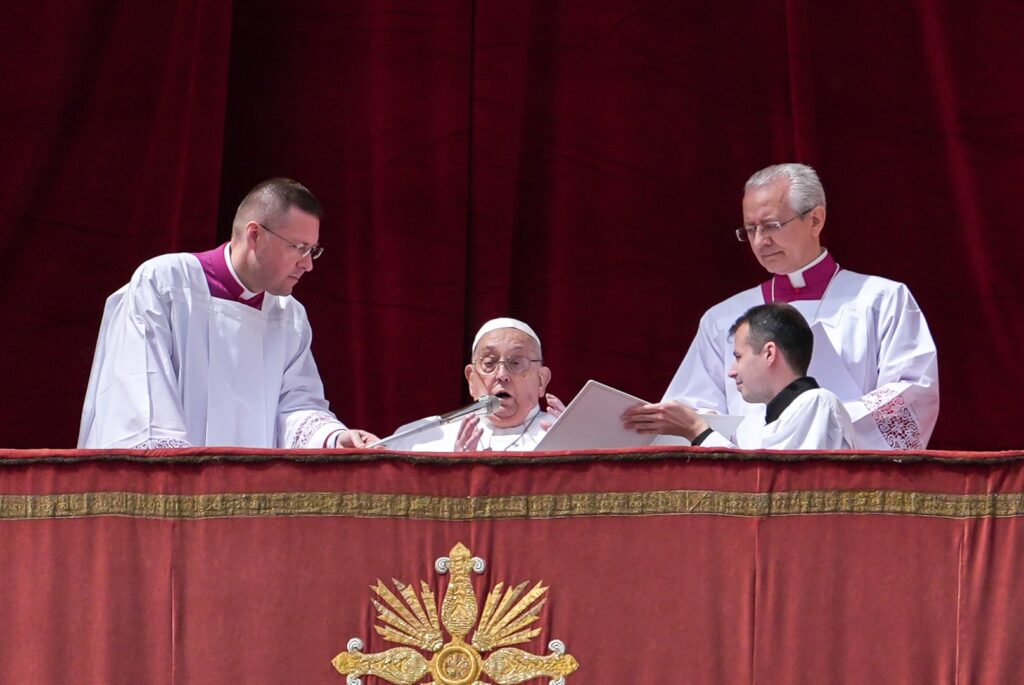
Pope on Easter: Jesus' Resurrection Makes Christians Pilgrims of Hope
By: Our Sunday Visitor
“Together with the risen Jesus,” he wrote in his message, those who trust in God “become pilgrims of hope, witnesses of the victory of love and of the disarmed power of life”

VATICAN CITY (CNS) — Pope Francis wrote in his Easter message that Christians’ hope is not a sign of avoiding reality but of trusting in God’s power to defeat sin and death, as the resurrection of Jesus clearly shows.
“All those who put their hope in God place their feeble hands in his strong and mighty hand; they let themselves be raised up and set out on a journey,” said the message, read before Pope Francis gave his Easter blessing “urbi et orbi” (to the city and the world) April 20.
The pope’s voice was weak, as it has been since he was released from the hospital March 23, and he barely raised his arms as he made the sign of the cross, but the tens of thousands of people in St. Peter’s Square were appreciative and clapped loudly after saying, “Amen.”
“Together with the risen Jesus,” he wrote in his message, those who trust in God “become pilgrims of hope, witnesses of the victory of love and of the disarmed power of life.”
The 88-year-old pope, who is still recovering from pneumonia, was not present at the Easter morning Mass in St. Peter’s Square but arrived shortly after noon to give the solemn blessing.
U.S. Vice President JD Vance and his family did not attend the Mass either, but Vance arrived at the Vatican at about 11:30 a.m. for a private meeting with Pope Francis in the papal residence, the Domus Sanctae Marthae. The Vatican said the meeting lasted just a few minutes and allowed the two to exchange Easter greetings.
Vance had met April 19 with Cardinal Pietro Parolin, Vatican secretary of state, and with Archbishop Paul R. Gallagher, the Vatican foreign minister. The Vatican said they discussed efforts to defend religious freedom as well as the international situation, especially regarding countries affected by war, political tensions and difficult humanitarian situations, with particular attention to migrants, refugees and prisoners.”
Security in and around St. Peter’s Square was tight. Just outside the square, an Italian army officer manned a large anti-drone gun, which he said uses electromagnetic pulses to disable the drone operator’s ability to control it.
With his voice still weak, Pope Francis wished everyone a Happy Easter and then asked his master of liturgical ceremonies, Archbishop Diego Ravelli, to read his message, which insisted that “Easter is the celebration of life!”
“God created us for life and wants the human family to rise again,” he wrote. “In his eyes, every life is precious! The life of a child in the mother’s womb, as well as the lives of the elderly and the sick, who in more and more countries are looked upon as people to be discarded.”
Pope Francis condemned the “great thirst for death” seen in violence and wars around the world and in the “contempt” people, including government leaders, direct toward “the vulnerable, the marginalized and migrants!”
As is traditional for the message, the pope also prayed for peace in war-torn nations, mentioning by name: Israel, Palestine, Ukraine, Yemen, Sudan, South Sudan, Congo and Myanmar.
Pope Francis condemned “the growing climate of antisemitism throughout the world.” But he also called attention to “the people of Gaza, and its Christian community in particular, where the terrible conflict continues to cause death and destruction and to create a dramatic and deplorable humanitarian situation.”
“I appeal to the warring parties: call a ceasefire, release the hostages and come to the aid of a starving people that aspires to a future of peace,” the papal message said.
Pope Francis had chosen Cardinal Angelo Comastri, retired archpriest of St. Peter’s Basilica, to be his delegate to preside over the morning Mass and read his homily.
Some 50,000 tulips, daffodils, hyacinths, roses and other flowers and bushes decorated the steps leading up to St. Peter’s Basilica while garlands framed the main entrance to the atrium of the basilica and adorned the central balcony.
Because Easter fell on the same day on the Julian and Gregorian calendars, meaning Catholic and Orthodox were celebrating on the same day, the Vatican added Byzantine “stichera” or hymns and “stichos” or Psalm verses after the chanting of the Gospel in Latin and in Greek.
The homily the pope prepared focused on the Easter Gospel’s description of Mary Magdalene running to tells the disciples that Jesus had risen and Peter and John running to verify the news.
Running, the pope wrote, “expresses the desire, the yearning of the heart, the inner attitude of those who set out to search for Jesus.”
And because he has risen from the dead, people must look for Jesus in someplace other than the tomb, the pope’s text said.
“We must take action, set out to look for him: look for him in life, look for him in the faces of our brothers and sisters,” he said. “We must look for him without ceasing. Because if he has risen from the dead, then he is present everywhere, he dwells among us, he hides himself and reveals himself even today in the sisters and brothers we meet along the way, in the most ordinary and unpredictable situations of our lives.”
Jesus “is alive and is with us always, shedding the tears of those who suffer and adding to the beauty of life through the small acts of love carried out by each of us,” Pope Francis wrote.
After the Mass, the Easter blessing, Pope Francis got in the popemobile and rode around St. Peter’s Square, waving to the crowd and blessing babies.

